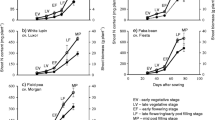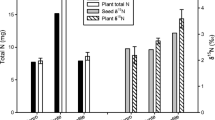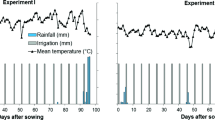Abstract
Quantifying biologically fixed nitrogen (BNF) by legumes through the 15N natural abundance techniques requires correct determination of a so-called B value. We hypothesized that significant variations in B values exist between faba bean (Vicia faba L.) varieties having consequences for BNF and N balance calculations. We experimentally determined B values for a range of faba bean varieties and quantified to what extent variety has an effect on B values and hence BNF quantification. Seeds of six faba bean varieties released in Ethiopia were inoculated with Rhizobium fabae strain LMG 23997-19 and grown in vermiculite with an N-free nutrient solution in a growth room until full flowering. Total N and 15N content of nodules, roots, and shoot components was analyzed separately to determine the weighted whole plant 15N fractionation during N2 fixation, i.e., the B value. Owing to its large seed size and high N content, a correction for seed N was carried out. We then calculated the percentage of N derived from air (%Ndfa), BNF, and N balance for faba beans grown in the field using three B value scenarios (variety specific B value corrected for seed N, variety specific B value without seed N correction, and a literature derived B value). Whole plant seed N corrected B values were significantly different (P < 0.05) between varieties and varied between +0.5 ± 0.4 and −1.9 ± 1.4‰ suggesting a variable isotope fractionation during N2 fixation. The %Ndfa was significantly (P < 0.05) different between varieties (59 ± 4.2–84 ± 4.5 %) using seed N corrected B values. BNF (218 ± 26.2–362 ± 34.7 kg N ha−1) was significantly (P < 0.05) different between varieties for corrected and uncorrected B values. Soil N balance did not result in statistically significant (P > 0.05) difference between varieties for all three B value scenarios. Use of inappropriate B values masked the difference between varieties and affected their ranking in terms of BNF, resulting from an over- to underestimation of 15 and 19 %, respectively. When applying the 15N natural abundance technique to compare BNF of legume accessions, we recommend determining a B value for each accession. For legumes with large seeds such as faba beans, it is moreover essential to account for seed N when determining the B value.

Similar content being viewed by others
References
Amanuel G, Asefa T, Tanner DG, Mwangi W (1991) On-farm research to derive fertilizer recommendations for small-scale bread wheat production. Methodological issues and technical results. Research report no. 14. IAR, Addis Ababa, Ethiopia
Amanuel G, Kuhne RF, Tanner DG, Vlek PLG (2000) Biological nitrogen fixation in faba bean (Vicia faba L.) in the Ethiopian highlands as affected by P fertilization and inoculation. Biol Fertil Soils 32:353–359
Boddey RM, Peoples MB, Palmer B, Dart PJ (2000) Use of the 15N natural abundance technique to quantify biological nitrogen fixation by woody perennials. Nutr Cycl Agroecosyst 57:235–270
Chianu JN, Nkonya EM, Mairura FS, Justina NC, Akinnifesi FK (2011) Biological nitrogen fixation and socioeconomic factors for legume production in sub-Saharan Africa: a review. Agron Sustain Dev 31:139–154
Dawson TE, Mambelli S, Plamboeck AH, Templer PH, Tu KP (2002) Stable isotopes in plant ecology. Annu Rev Ecol Syst 33:507–559
Doughton JA, Vallis I, Saffigna PG (1992) An indirect method for estimating 15N isotope fractionation during nitrogen fixation by a legume under field conditions. Plant Soil 144:23–29
Fan F, Zhang F, Song Y, Sun J, Bao X, Guo T, Li L (2006) Nitrogen fixation of faba bean (Vicia faba L.) interacting with a non-legume in two contrasting intercropping systems. Plant Soil 283:275–286
Habtemichial KH, Singh BR, Aune JB (2007) Wheat response to N2 fixed by faba bean (Vicia faba L.) as affected by sulfur fertilization and rhizobial inoculation in semi-arid Northern Ethiopia. J Plant Nutr Soil Sci 170:412–418
Handley LL, Scrimgeour CM (1997) Terrestrial plant ecology and 15N natural abundance: the present limits to interpretation for uncultivated systems with original data from a Scottish old field. Adv Ecol Res 27:133–212
Hardarson G, Bliss FA, Cigales-Rivero MR, Henson RA, Kipe-Nolt JA, Longeri L et al (1993) Genotypic variation in biological nitrogen fixation by common bean. Plant Soil 152:59–70
Herridge DF, Peoples M, Boddey RM (2008) Global inputs of biological nitrogen fixation in agricultural systems. Plant Soil 311:1–18
Högberg P (1997) 15N natural abundante in soil–plant systems. New Phytol 137:179–203
Högberg P, Näsholm T, Högbom L, Stahl L (1994) Use of 15N labeling and 15N natural abundance to quantify the role of mycorrhizas in N uptake by plants: importance of seed N and of changes in the 15N labeling of the available N. New Phytol 127:515–519
Houngnandan P, Yemadje RGH, Oikeh O, Djidohokpin CF, Boeckx P, Van Cleemput O (2008) Improved estimation of biological nitrogen fixation of soybean cultivars (Glycine max L. Merril) using 15N natural abundance technique. Biol Fertil Soils 45:175–183
Köpke U, Nemecek T (2010) Ecological services of faba bean. Field Crop Res 115:217–233
Kyei-Boahen S, Slinkard AE, Walley FL (2002) Isotopic fractionation during N2 fixation by chickpea. Soil Biol Biochem 34:417–420
López-Bellido FJ, López-Bellido RJ, Redondo R, López-Bellido L (2010) B value and isotopic fractionation in N2 fixation by chickpea (Cicer arietinum L.) and faba bean (Vicia faba L.). Plant Soil 337:425–434
Maidl FX, Haunz FX, Panse A, Fischbeck G (1996) Transfer of grain legume nitrogen within a crop rotation containing winter wheat and winter barley. J Agron Crop Sci 176:47–57
Nebiyu A, Diels J, Boeckx P (2010) Performance of elite faba bean (Vicia faba L.) varieties at two different altitudes on Nitisols of southwestern Ethiopia. Soil Science Society of Belgium, 23 February 2010, Brussels, Belgium. http://www.bbvbss.ugent.be/downloads/yss2010/amsalu.pdf
Nguluu SN, Probert ME, McCown RL, Myers RJK, Waring SA (2001) Isotopic discrimination associated with symbiotic nitrogen fixation in stylo (Stylosanthes hamata L.) and cowpea (Vigna unguiculata L.). Nutr Cycl Agroecosyst 62:11–14
Norris DO, Date RA (1976) Legume bacteriology. In: Shaw NH and Bryan WW (eds.) Tropical pasture research—principles and methods. Commonwealth Bureau and Pastures and Field Crops Bulletin No. 51, Oxford, pp. 171-174
Okito A, Alves BRJ, Urquiaga S, Boddey RM (2004) Isotopic fractionation during N2 fixation by four tropical legumes. Soil Biol Biochem 36:1179–1190
Pate JS, Unkovich MJ, Armstrong EL, Sanford P (1994) Selection of reference plants for 15N natural abundance assessment of N2 fixation by crop and pasture legumes in south-west Australia. Aust J Agric Res 45:133–147
Peoples MB, Turner GL, Shah Z, Shah SH, Aslam M, Ali S, Markey SL, Afandi F, Schwenke GD, Herridge DF (1997) Evaluation of the 15N natural abundance technique for measuring N2 fixation in experimental plots and farmer’s fields. In: Rupela OP, Johansen C, Herridge DF (eds) Extending nitrogen fixation research to farmers’ fields. ICRISAT, Patancheru, India, pp 57–75
Peoples MB, Brockwell J, Herridge DF, Rochester I, Alves B, Boddey R, Dakora F, Bhattari S, Maskey S, Sampet C, Rerkesam B, Khan D, Hauggaard-Nielsen H, Jensen E (2009a) The contribution of nitrogen fixing crop legumes to the productivity of agricultural systems. Symbiosis 48:1–17
Peoples MB, Unkovich MJ, Herridge DF (2009b) Measuring symbiotic nitrogen fixation by legumes. In: David W, Emerich DW, Krishnan HB (eds) Nitrogen fixation in crop production. Agronomy Monograph 52. American Society of Agronomy, Madison, pp 125–170
Robinson D, Handley LL, Scrimgeour CM (1998) A theory for 15N/14N fractionation in nitrate-grown vascular plants. Planta 205:397–406
Rodriguez-Navarro DN, Buendia AM, Camacho M, Lucas MM, Santamaria C (2000) Characterization of Rhizobium spp. bean isolates from south-west Spain. Soil Biol Biochem 32:1601–1613
Salvagiotti F, Cassman K, Specht J, Walters D, Weiss A, Dobermann A (2008) Nitrogen uptake, fixation and response to fertilizer N in soybeans: a review. Field Crop Res 108:1–13
SAS (Statistical Analysis System) (2008) SAS/STAT 9.2 user’s guide. SAS institute Inc, Cary
Shearer G, Kohl DH (1986) N2-fixation in field settings: estimations based on natural 15N abundance. Funct Plant Biol 13:699–756
Shearer G, Kohl DH (1988) Natural 15N abundance as a method of estimating the contribution of biologically fixed nitrogen to N2 fixing systems: potential for non-legumes. Plant Soil 110:317–327
Unkovich MJ, Pate JS (2000) An appraisal of recent field measurements of symbiotic N2 fixation by annual legumes. Field Crop Res 65:211–228
Unkovich MJ, Pate JS, Armstrong EL (1994) Potential precision of the δ15N natural abundance method in field estimated of nitrogen fixation by crop and pasture legumes in south-west Australia. Aust J Agric Res 45:119–132
Unkovich MJ, Herridge D, Peoples M, Cadisch G, Boddey R, Giller K, Alves B, Chalk P (2008) Measuring plant-associated nitrogen fixation in agricultural systems. ACIAR Monograph No. 136, 258 pp
Unkovich MJ, Baldock J, Peoples MB (2010) Prospects and problems of simple linear models for estimating symbiotic N2 fixation by crop and pasture legumes. Plant Soil 329:75–89
Vincent JM (1970) A manual for the practical study of root nodule bacteria. Blackwell Scientific, Oxford, p 164
Wanek W, Arndt SK (2002) Differences in delta15N signatures between nodulated roots and shoots of soybean is indicative of the contribution of symbiotic N2 fixation to the plant. J Exp Bot 53:1109–1118
Acknowledgments
The authors would like to thank financial support from VLIR-UOS in the framework of an Inter University Cooperation program with Jimma University, Ethiopia. Katja Van Nieuland is duly acknowledged for 15N analysis. Mr. Daniel Damtew and Mr. Alemseged Amanuel are duly acknowledged for kindly assisting in data collection in the field.
Author information
Authors and Affiliations
Corresponding author
Rights and permissions
About this article
Cite this article
Nebiyu, A., Huygens, D., Upadhayay, H.R. et al. Importance of correct B value determination to quantify biological N2 fixation and N balances of faba beans (Vicia faba L.) via 15N natural abundance. Biol Fertil Soils 50, 517–525 (2014). https://doi.org/10.1007/s00374-013-0874-7
Received:
Revised:
Accepted:
Published:
Issue Date:
DOI: https://doi.org/10.1007/s00374-013-0874-7




